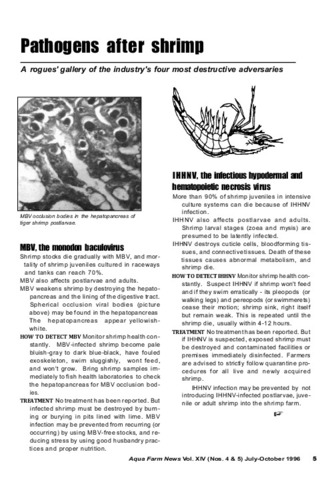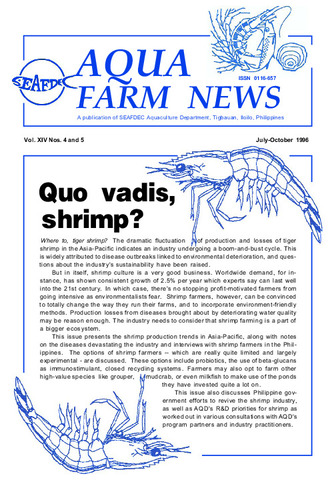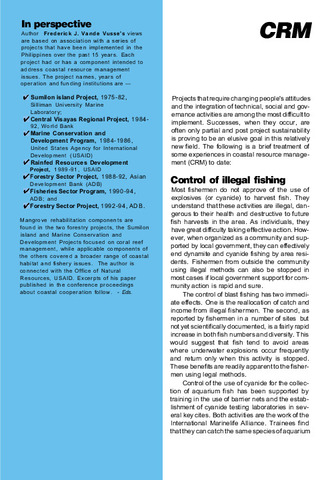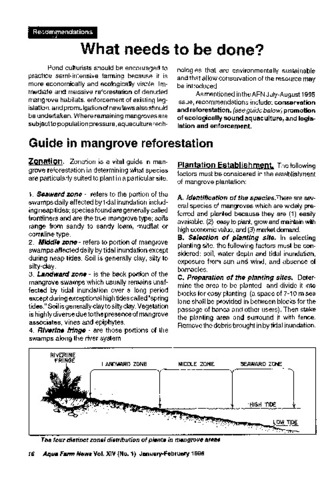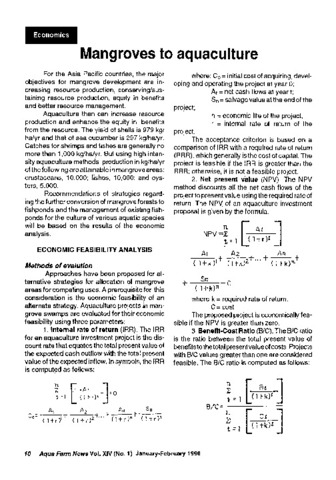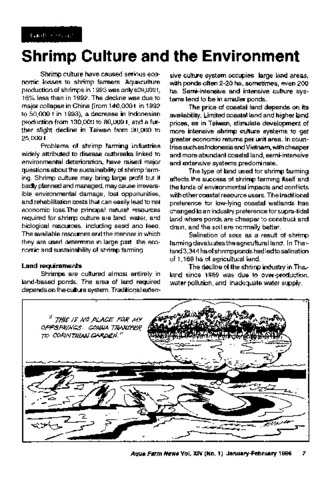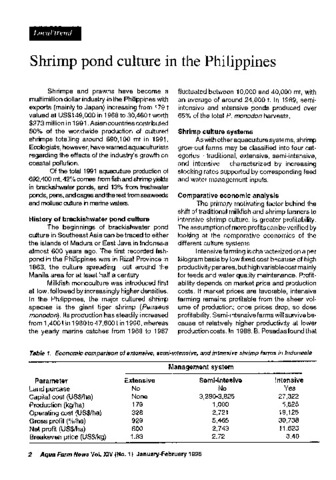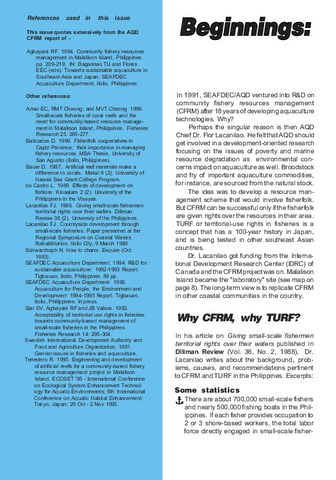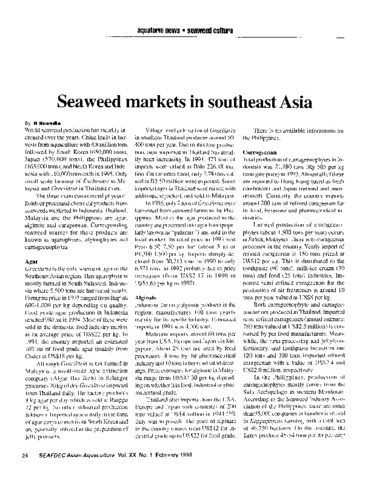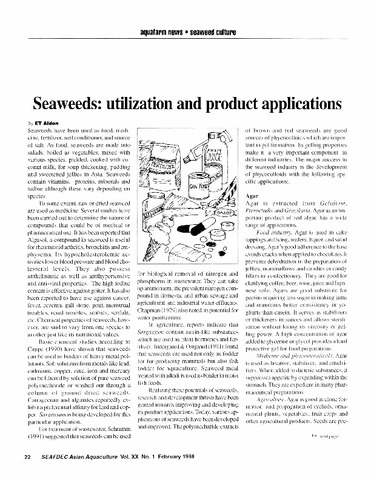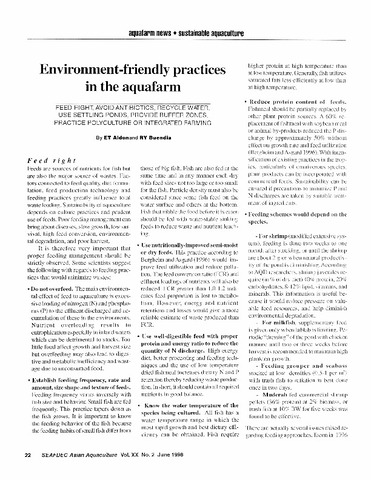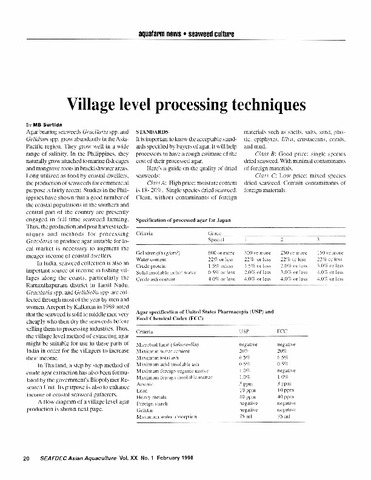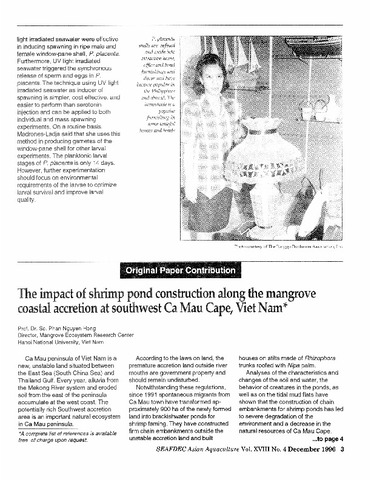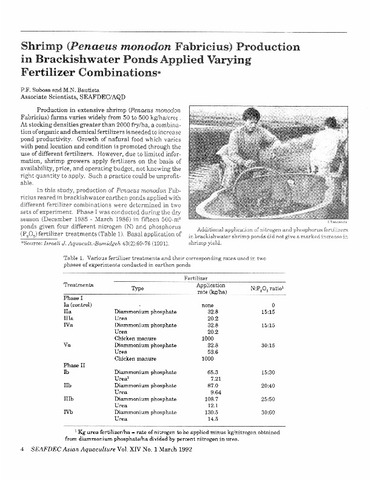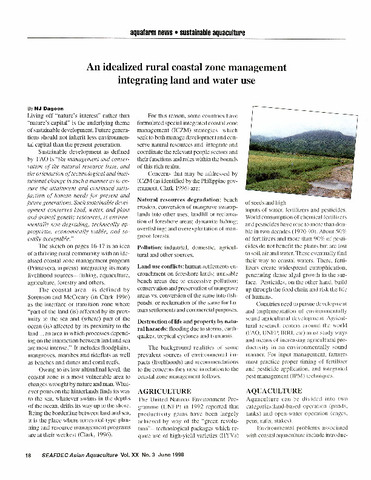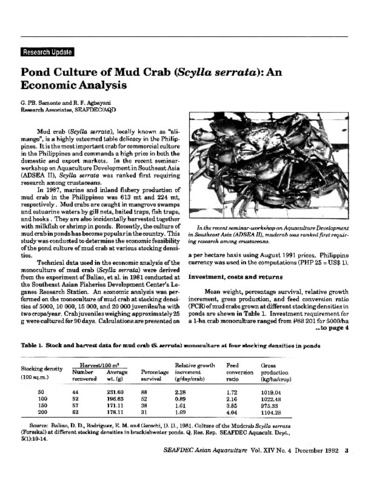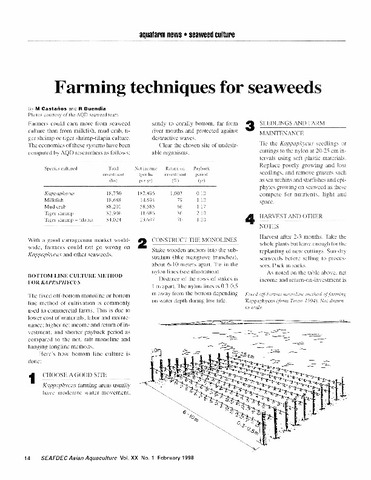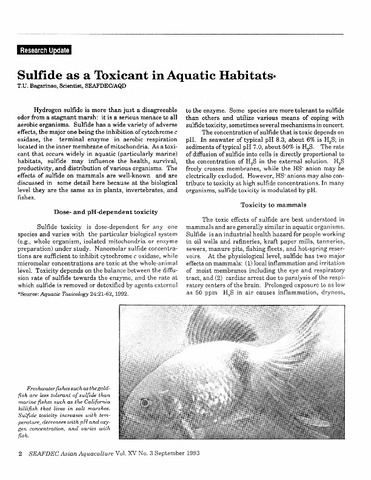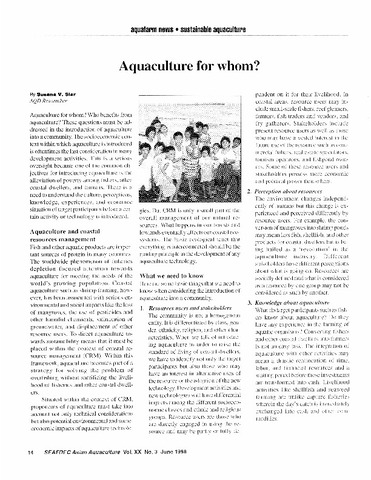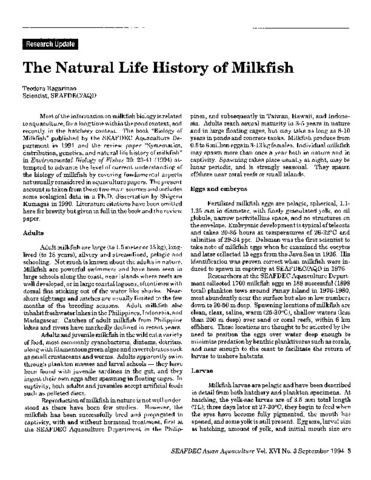Journals/Magazines: Recent submissions
Now showing items 481-500 of 591
-
Pathogens after shrimp: A rogue's gallery of the industry's four most destructive adversaries
(Aquaculture Department, Southeast Asian Fisheries Development Center, 1996)The paper discusses the four most destructive shrimp pathogens, such as MBV, the monodon baculovisrus, IHHNV, the infectious hypodermal and hematopoietic necrosis virus, Vibrio harveyi, the luminous bacteria, and WSBV, the ... -
Quo vadis, shrimp?
(Aquaculture Department, Southeast Asian Fisheries Development Center, 1996)The paper discusses the shrimp culture practices of Thailand, the top producing country of cultured shrimp. These shrimp culture techniques include the use of reservoirs for better waste management, utilization of undiluted ... -
CRM in the Philippines: Lessons learned
(Aquaculture Department, Southeast Asian Fisheries Development Center, 1996)Philippine coastal communities can become capable fishery resource managers and that their management practices can become largely self-sustaining if the project approach focuses on assisting fishermen to learn how to help ... -
What needs to be done?: Guide in mangrove reforestation
(Aquaculture Department, Southeast Asian Fisheries Development Center, 1996)The article presents a two-part guideline in mangrove reforestation. The first part is zonation, which is the process of determining what species are particularly suited to plant in a particular site. While, plantation ... -
Mangroves to aquaculture
(Aquaculture Department, Southeast Asian Fisheries Development Center, 1996)The paper discusses the recommended strategies regarding the further conversion of mangrove forests to fishponds and the management of existing fishponds for the culture of various aquatic species based on economic feasibility ... -
Shrimp culture and the environment
(Aquaculture Department, Southeast Asian Fisheries Development Center, 1996)The paper discusses the impacts of shrimp culture to the environment in some countries in Asia. Specifically, it highlights the land requirements suitable for shrimp farming and the impacts of shrimp culture on mangroves. ... -
Shrimp pond culture in the Philippines
(Aquaculture Department, Southeast Asian Fisheries Development Center, 1996)The document reviews and evaluates the development of shrimp culture in the Philippines. It also discusses the ecological and socioeconomic effects of shrimp culture industry in the country. -
Beginnings: SEAFDEC/AQD, CFRM, and Malalison Island
(Aquaculture Department, Southeast Asian Fisheries Development Center, 1996)The paper documents the community fishery resources management activities of Southeast Asian Fisheries Development Center, Aquaculture Department (SEAFDEC/AQD) in Malalison Island, Antique, Philippines. -
Seaweed markets in southeast Asia
(Aquaculture Department, Southeast Asian Fisheries Development Center, 1998)World seaweed production has steadily increased over the years. The 3 main commercial phycocolloids or processed chemical products from seaweeds marketed in Indonesia, Thailand, Malaysia and the Philippines are agar, ... -
Seaweeds: Utilization and product applications
(Aquaculture Department, Southeast Asian Fisheries Development Center, 1998)Seaweeds have been used as food, medicine, fertilizers, soil conditioner and source of salt. Realizing the potentials of seaweeds, research and development thrusts have been geared towards improving and developing its ... -
Environment-friendly practices in the aquafarm
(Aquaculture Department, Southeast Asian Fisheries Development Center, 1998)An outline is given of various environment-friendly management practices in aquaculture, considering the following: 1) feed right; 2) avoid antibiotics; 3) reuse and cycle water; 4) use settling or sedimentation ponds; 5) ... -
Village level processing techniques
(Aquaculture Department, Southeast Asian Fisheries Development Center, 1998)The agar-bearing seaweeds Gracilaria and Gelidium grow abundantly in the Asia-Pacific region. Production and post-harvest techniques and methods for processing Gracilaria to produce agar suitable for local market is necessary ... -
The impact of shrimp pond construction along the mangrove coastal accretion at southwest Ca Mau Cape, Viet Nam
(Aquaculture Department, Southeast Asian Fisheries Development Center, 1996) -
Shrimp (Penaeus monodon Fabricius) production in brackishwater ponds applied varying fertilizer combinations
(Aquaculture Department, Southeast Asian Fisheries Development Center, 1992)Details are given of the production of Penaeus monodon in the Philippines reared in brackishwater earthen ponds applied with different fertilizer combinations, namely diammonium phosphate, urea and chicken manure. Results ... -
An idealized rural coastal zone management integrating land and water use
(Aquaculture Department, Southeast Asian Fisheries Development Center, 1998)Various countries have formulated special integrated coastal zone management (ICZM) strategies which seek to both manage development and conserve natural resources and integrate and coordinate the relevant people sectors ... -
Pond culture of mud crab (Scylla serrata): An economic analysis
(Aquaculture Department, Southeast Asian Fisheries Development Center, 1992)The findings are presented of a study conducted to determine the economic feasibility of the pond culture of mud crab (Scylla serrata) at various stocking densities. Investments, costs, and returns are given for a 1 ha ... -
Farming techniques for seaweeds
(Aquaculture Department, Southeast Asian Fisheries Development Center, 1998)Details are given of farming methods developed by the SEAFDEC Aquaculture Department for 3 different seaweeds: 1) Bottom line culture method for Kappaphycus; 2) Pond culture of Gracilaria; and, 3) Gracilariopsis bailinae, ... -
Sulfide as a toxicant in aquatic habitats
(Aquaculture Department, Southeast Asian Fisheries Development Center, 1993)The toxic effects of sulphide are best understood in mammals and are generally similar in aquatic organisms. At the physiological level sulphide has 2 major effects on mammals: 1) local inflammation and irritation of moist ... -
Aquaculture for whom?
(Aquaculture Department, Southeast Asian Fisheries Development Center, 1998)Aquaculture and coastal resources management is discussed, indicating the various factors which need to be taken into consideration when introducing aquaculture into a community: 1) Resources users and stakeholders; 2) ... -
The natural life history of milkfish
(Aquaculture Department, Southeast Asian Fisheries Development Center, 1994)Following brief descriptions of the various phases in the natural life history of the milkfish (Chanos chanos), namely adults, eggs and embryos, larvae, fry and metamorphosis, juveniles and sub-adults, a summary is provided ...

